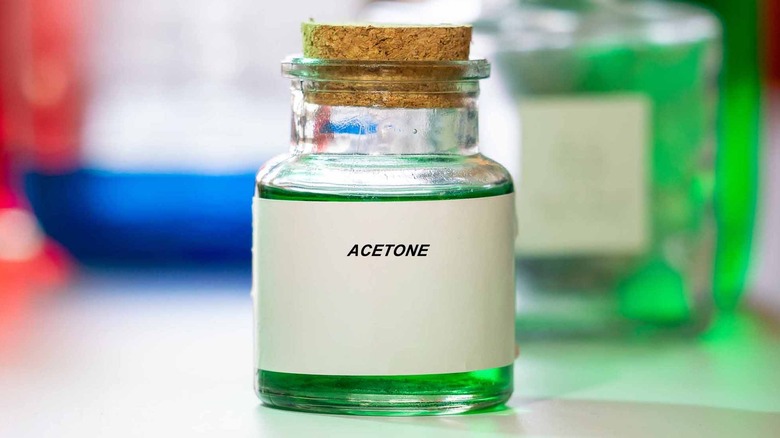How To Tell If Wine Has Gone Bad
Wine experts are trained to look for bad wine. Most wine drinkers can spot one if they know what to look for. These days, fewer wines are flawed due to modern wine-making techniques. Faults do happen, though, and with a little practice, you'll be able to spot them just like a pro.
According to Bon Appétit, most wine faults and impurities can be detected just by smelling a wine. Flaws have specific scents that give the wine off-aromas. Some are easy to detect and others take a little training to distinguish between a healthy wine and a bad wine. Visual cues are another indicator that a bottle of wine is bad. Some wines appear murky or cloudy or they will contain tiny air bubbles when there shouldn't be any.
Food & Wine reports that wines go bad when bacteria, mold, yeast, and other microbes interact with the wine, causing a chemical reaction that changes the quality and nature of the wine. These chemical reactions result in "bad wine" by altering the wine's aromas, flavors, and textures. With this said, here are a few specific signs to look for when determining if a wine has gone bad or not.
Oxygen
Oxidation and reduction are opposite ends of one issue: oxygen. Wine Folly suggests that wine that has dull flavors and aromas and looks brownish is likely oxidized, meaning the wine was exposed to too much oxygen. Some fortified wines like amontillado and oloroso sherry, Madeira, and certain port wines rely on oxidation for signature aromas and flavors, but oxidation is a fault in table wines. Wine Folly adds that heat damage results in a maderized cooked character, while light damage results in a wet wool aroma and flavor — clear signs the wine has gone bad.
Wine Enthusiast, meanwhile, states that the skunky aroma notes of burnt matches, rotten eggs, burned garlic, cooked cabbage, and burnt rubber indicate a potentially bad kind of wine, one with too much sulfur in it. A lack of oxygen during wine-making leads to a sulfur imbalance. The good news is that sulfur notes often blow off and some wines can be saved by decanting them, exposing the wine to oxygen.
Cork taint
People use the term "corked" to describe all types of wine faults. VinePair points out that only about 5% of wines are corked. Cork stoppers for wine bottles come from the porous bark of a specific type of oak tree that grows in Portugal. Per Wine-Searcher, the bark contains scant amounts of microbes that occur naturally as the tree grows. Occasionally, the cork will be infected with chlorophenol or chloroanisole compounds, which interact with a fungus to create 2,4,6-trichloroanisole, or TCA, commonly known as cork taint.
According to Wine Spectator, TCA has a distinctive musty aroma that resembles wet newspapers. Once you know it, you never forget it. TCA dampens the vibrant aromas and flavors of wine, leaving it flat. While TCA isn't harmful, it tastes awful, letting you know the wine's gone bad. Sometimes corks will break into pieces or have little white crystals on the interior end. Neither suggests that your wine is corked. Wines with synthetic corks and screw caps are never corked.
Volatile acidity
Volatile acidity is another fault that can be an amazing asset, given the wine. Abundant volatile acidity gives wine an aroma of vinegar, acetone, or nail polish. It's often the result of unhygienic practices and is caused by a chemical reaction where certain bacteria strains convert alcohol to vinegar, per Wine Enthusiast, which adds that while volatile acidity may be a sign of bad table wine, some fortified wines purposely contain high levels of volatile acidity as part of their ideal character.
In fact, different styles of sherry exude volatile acidity that when in balance with the alcohol levels and other aromas and flavors, can be quite pleasing. Sherry Notes describes fino and manzanilla as the lowest in volatile acidity because they're fermented under a protective layer of flor, a gossamer yeasty substance that protects the wine from exposure to oxygen. This suggests that amontillado and oloroso sherry contain higher levels.
Brettanomyces
Wine Folly describes Brettanomyces as a specific strain of non-spore forming fungal yeast that produces generous amounts of acetic acid during the fermentation process; it's known for its rustic, wet saddle leather notes that are great in some wines. Wine Enthusiast implies that when Brettanomyces yeast (known as Brett yeast), most common in beer, leads to a wet horse, funky barnyard, slightly metallic, or band-aid aroma, it is almost always a flaw.
However, when the aromas and flavors gain a gamey, bacon, or smoky note, Brett is considered a gift. Some people enjoy Brett in red wines like syrah or cabernet sauvignon because it resembles the flavor and aroma notes often found in prized aged wines. Some producers encourage Brett in their wineries to impart this unique sensory characteristic into their wines. On the other hand, bacteria overgrowth creates a mousy smell and always leads to a bad wine. Toss it or return it.
Murky appearance
Most wines are translucent and glisten in the light. Some wines, though, are supposed to be opaque. Winemakers may opt not to filter their wines as a stylistic choice. This said, most wines should be clear, bright, and translucent. When they're murky, there is likely something amiss — a sign of a wine gone bad. Bubbles make sparkling wine delightful but when a table wine has bubbles, it's a mistake, per Wine Folly. Bubbles indicate an unfinished fermentation and residual sugar in the wine. In such cases, decanting may help.
To sum it up, if wine looks cloudy, opaque, or brownish, it's bad or old. If it has debris floating in it, it's probably just old, but it could be bad. Look for a musty, wet dog, wet newspaper, sulfur, nail polish, rotten egg, or barnyard smell in your wine to determine if it has gone bad. If wine is too sour, sharp, oxidized when young, or has bubbles when it isn't supposed to, it is probably bad as well. File these experiences away in your wine memory database and you will know immediately when you have a bad wine.





